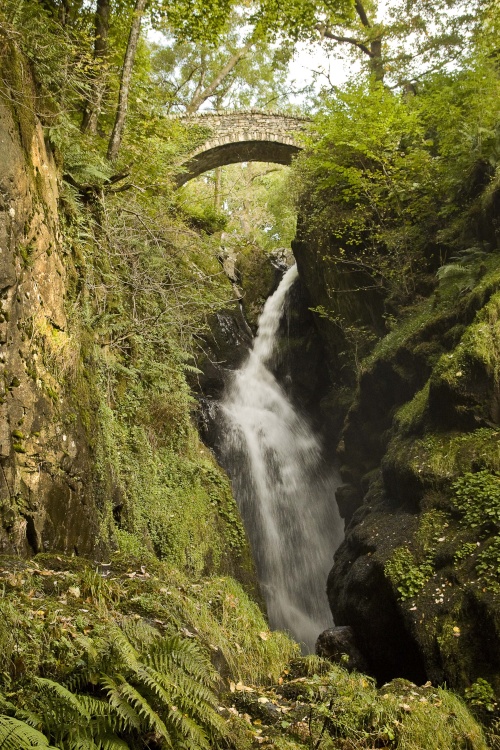
Aira Force 1 - Image by PicturesOfEngland.com member Dave John (view gallery)

Aira Force 1 - Image by PicturesOfEngland.com member Dave John (view gallery)
Beautiful lake winding through a glaciated valley, and an impressive waterfall which is a Victorian beauty spot.
ID#4131
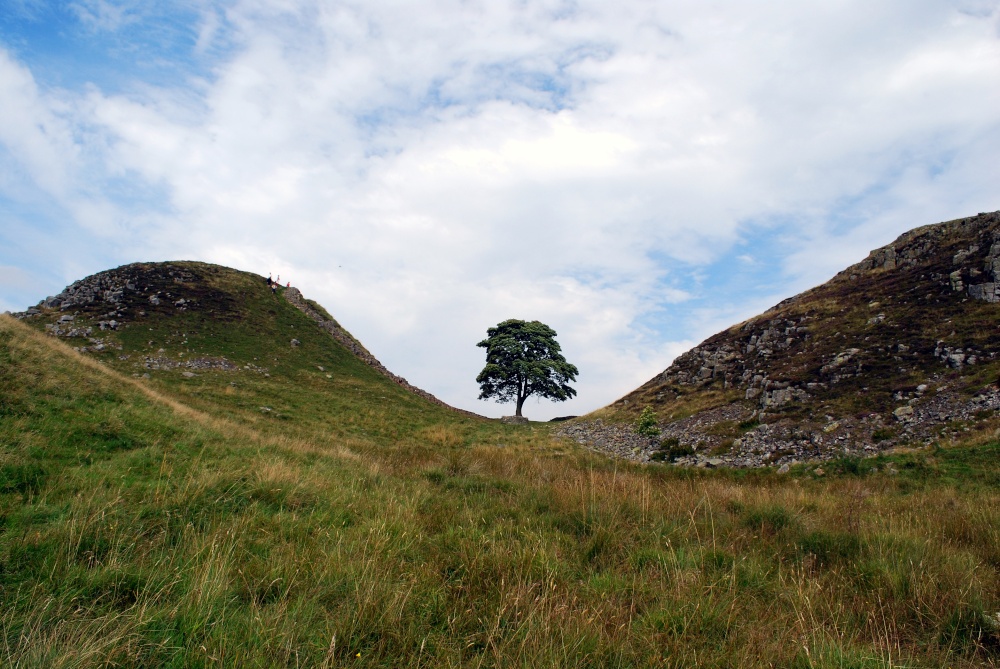
Hadrians Wall - Image by PicturesOfEngland.com member Ray Hutcheon (view gallery)
Sycamore Gap is a famous landmark along Hadrian's Wall - a famous wall in the north of England built by the Romans. The gap is a dip in the landscape caused by melting glacial waters underneath the sheet ice that once covered the area thousands of years ago.
The location was made famous by the film Robin Hood: Prince of Thieves (1991) starring Kevin Costner. It was also featured in the video to the popular theme song from the film, a song which was a huge hit for Bryan Adams. The Sycamore is often referred to as 'The Robin Hood tree' because of these associations.
The tree, which is several hundred years old, was entered into the 'England's Tree of the Year' competition and saw off 200 other trees to win the £1000 prize which goes towards its preservation.
The tree is also one of the most photographed trees in England.
ID#3511
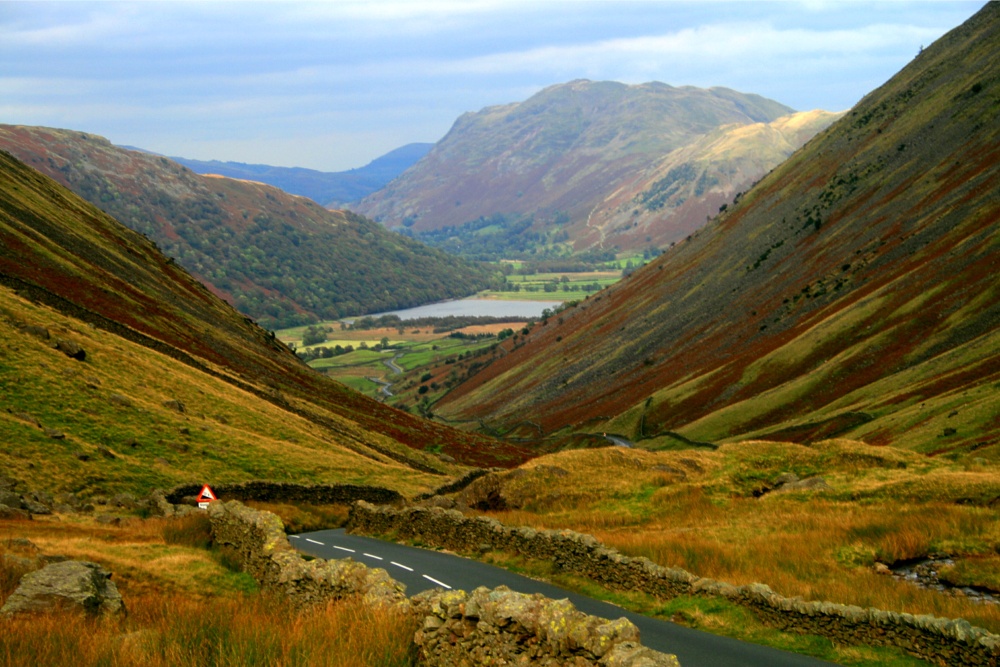
Kirkstone Pass, looking north. - Image by PicturesOfEngland.com member Roy Jackson (view gallery)
Kirkstone Pass in the Lake District is famous for its iconic view on the road to Ullswater from the town of Ambleside. There is an Inn at the top which dates from 1496AD and was once an important coaching inn.
The name of the Kirkstone Pass derives from 'The Kirkstone' which is a stone that stands on the roadside of the A592, near the inn, and its silhouette resembles a church steeple, which is what 'kirk' means in old Norse language.
The Kirkstone pass is the Lake District's highest pass that is open to motor traffic and has an altitude of 1,489 feet.
ID#10799
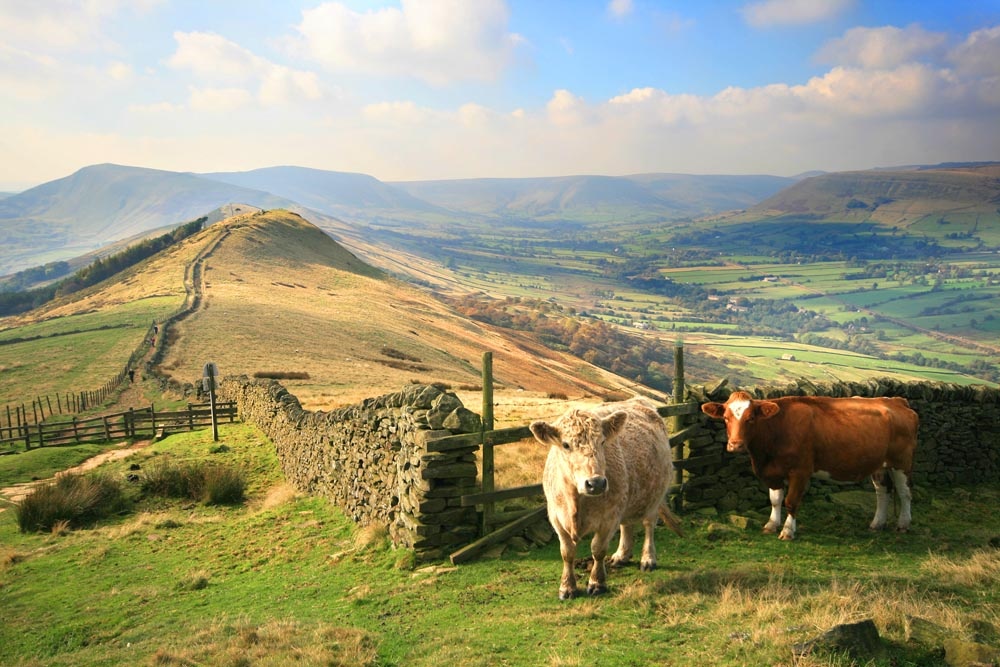
Mam Tor Ridge - Image by PicturesOfEngland.com member John Godley (view gallery)
Mam Tor, also known as 'The Shivering Mountain' is a famous beauty spot and landmark of the Peak District. At its summit are the remains of an iron-age hillfort
ID#10785
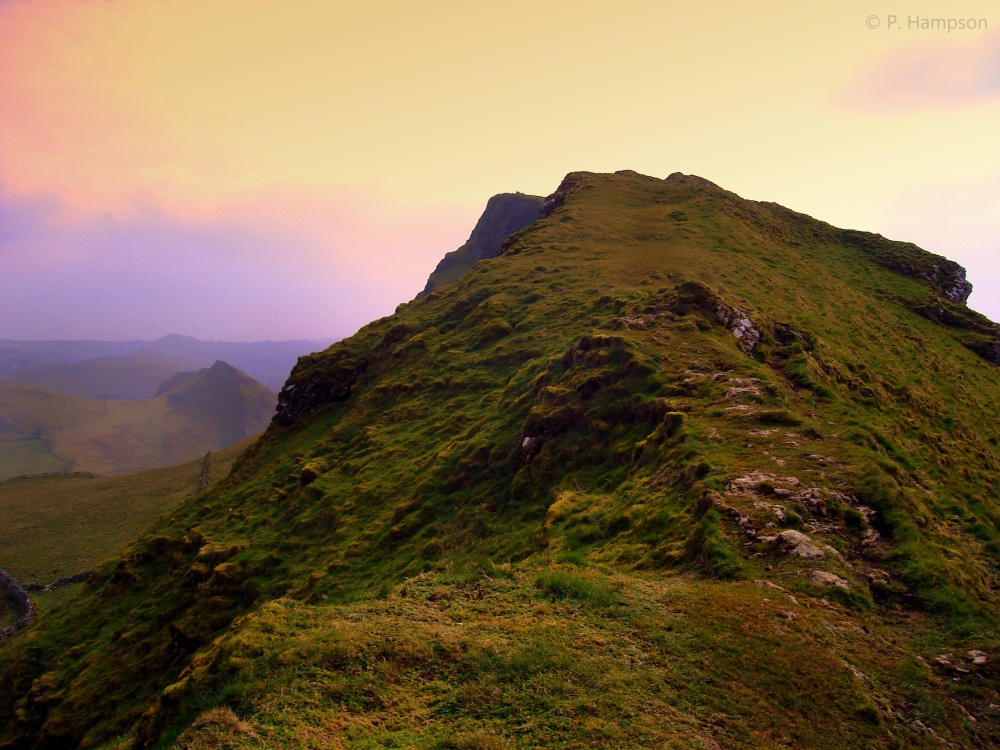
Chrome Hill with Parkhouse Hill in the distance. Situated near the hamlet of Hollinsclough. - Image by PicturesOfEngland.com member P. Hampson (view gallery)
ID#14012
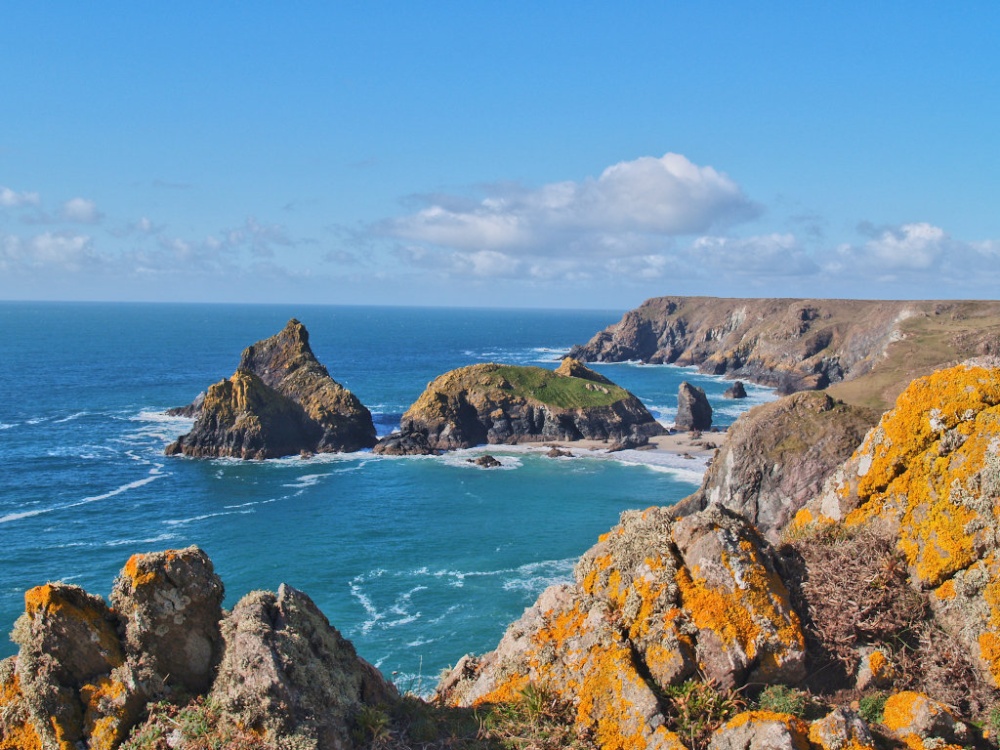
Kynance Cove Cornwall - Image by PicturesOfEngland.com member Peter Reddick (view gallery)
The scenery surrounding Kynance Cove is as dramatic as it is beautiful with cliffs of over 200ft in height rising on either side and a swirling ocean, covering the golden sand on the beach below. To watch the sun set and rise across the ocean from high above Kynance, is truly morning glory and mid-night sun, it renders a memorable moment that will live with you forever.
Once the sea retreats, the beach can be used for the period of low tide. The rocks that outline the bay are spectacular in both formation and colour. They are streaked with white, yellow, red and black and, parts of the formation is of a brilliant greyish-green. There is a wildness about this place and the cove is littered with ancient rocks that have been washed into the strangest shapes by the ceaseless pounding of gale lashed seas. On the headland above the cove, the ground is covered with a rich variety of wild flowers, they grow in wild profusion all along these cliffs and make it a mecca for naturalists from all over. The wonderful flora and fauna to be found along here has been well documented for over two centuries. Kynance Cove can be found between the Lizard and Predannack Head, it is a place of great beauty and unique atmosphere, that will call you back again and again.
ID#467
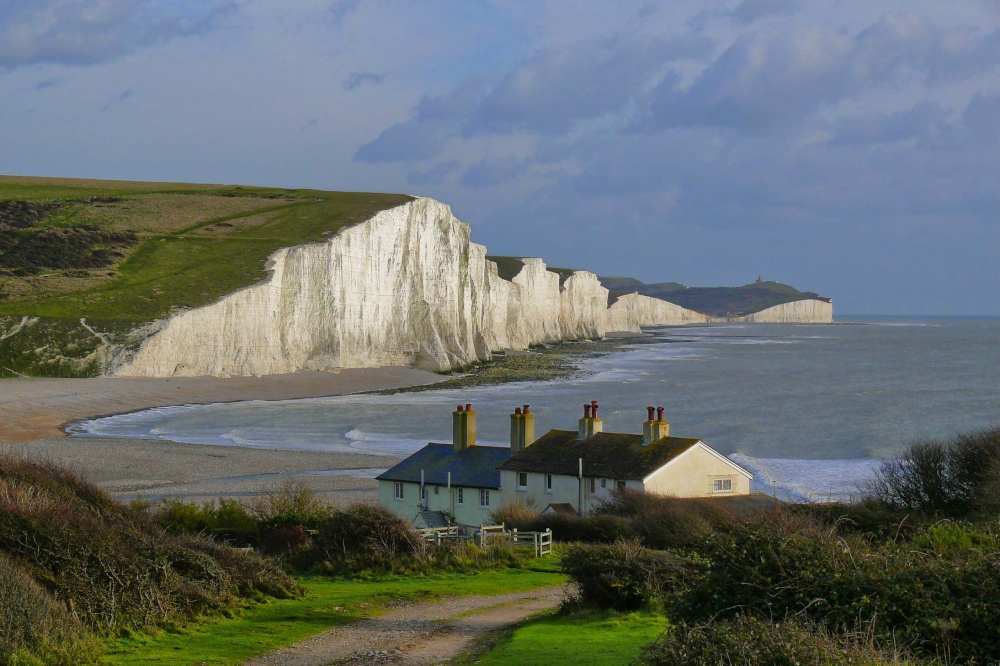
Seven Sisters - Image by PicturesOfEngland.com member Hudzik Piotr (view gallery)
Designated a site of Special Scientific Interest, in an Area of Outstanding Natural Beauty (AONB), the Seven Sisters Country Park is part of one of Britain's finest unspoilt coastlines, the Sussex Heritage Coast. The country park itself covers approx 700 acres (280 hectares) being made up of chalk cliffs, open chalk meadows, woodlands and meandering river valley. Great for activities such as walking, cycling, canoeing, birdwatching or simply having a picnic and taking in the stunning surroundings. Also in the area are a number of 18th century flint barns, one housing the tourist information centre, another is The Living Museum.
ID#9803
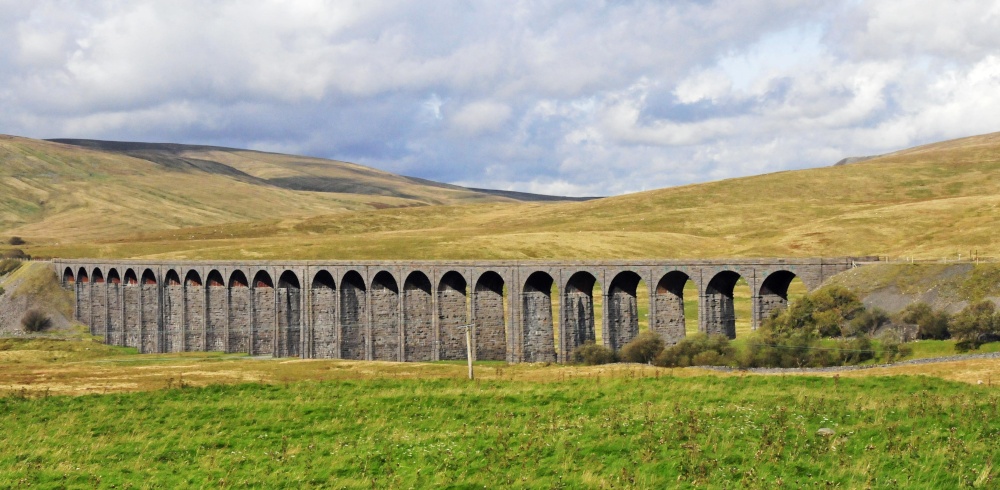
Ribblehead Viaduct - Image by PicturesOfEngland.com member Paul V. A. Johnson (view gallery)
The unyielding screach of a curlew from the skies above, is often the only sound heard in the far upland reaches of the lonely moorland and limestone hills of the supremely beautiful Yorkshire Dales. It is thought that the Dales sprang into life 300 million years ago when the earth upended the vast limestone rocks of the Pennines. Ten thousand years ago, the Ice Age glaciers melted, leaving behind deep valleys and lakes. The fact that this is an ancient landscape is undisputed and many of the little hamlets and villages have a history, almost lost in the mists of time. Many settlements belonging to the Norsemen who invaded these lands in the 9th and 10th-centuries remain scattered throughout the dales and it is they who formed and shaped the unique character of the landscape as we see it today. Dale is Norse for Valley and the strange sounding names such as beck instead of stream are a legacy of the invaders.
Ancient hamlets and pretty villages are strung throughout the dales, some such as REETH, once a centre for the lead industry, and like ASKRIGG, mentioned in the Domesday Book, grew up along the waters of the becks. In the far reaches of the dales, the beautiful ARKENGARTHDALE has several villages dotted along the banks of ARKLE BECK, a tributary of the RIVER SWALE which is edged with ancient stone farms. The lofty TAN HILL, crossed by Drovers' roads, is now the haunt of Grouse and Sheep, at a height of 1732ft The Tan Hill Inn is the highest inn in the dales and a haven for walkers. THE PENNINE WAY marches through the most spectacular areas of the dales as it crosses from TAN HILL to the RIVER AIRE at ESHTON. This magnificent route takes in HIGH FORCE and LOW FORCE, KISDON GORGE and the delightful village of THWAITE birthplace of naturalists, Richard and Cherry Kearton which shows a host of traditional moorland stone cottages. The journey continues through the BUTTER TUBS and on to HAWES, an interesting village with a fine visitors centre and the UPPER DALES FOLK MUSEUM, from here the way moves past GAYLE WATERFALL and towering WETHER FELL which rises majestically to a height of 2015ft, it skirts the beautiful RIVER RIBBLE` and passes the misty MALHAM TARN and the awe-inspiring MALHAM COVE to enter MALHAM village which stands amid some of the most rugged scenery in the Yorkshire Dales.
Romantic buildings are interspersed throughout the dales; CASTLE BOLTON was completed in 1399 following 18 years of building work. The castle was a prison home of Mary, Queen of Scots, the Queen was locked-up here for six months. Today, this fortress overshadows enchanting stone cottages and a 14th-century church, its rooms depict life in the 15th-century. The ruins of 12th-century JERVAULX ABBEY are unusual that they remain in private ownership, it was originally a Cistercian Foundation whose Abbot was executed for his part in the unsuccessful revolt against Henry VIII. BARNARD CASTLE, this ruinous Norman castle lies on the fringe of the dales on a rocky crag above this pleasant market town that is also home to the BOWES MUSEUM. KIPLIN HALL lies on the river swale. It is a wonderful Jacobean property of the 17th-century, built as a Hunting Lodge, it was once the home of Lord Baltimore, founder of the state of Maryland U.S.A. Recent restoration has brought the Hall back to an interesting Victorian residence of great comfort. Close to Barnard Castle village are two other historic buildings; EGGLESTONE ABBEY is a fabulous ruin of the 12th-century, whilst ROCKBY PARK is a handsom Palladian Mansion of great charm, it is open to the public and exhibits many treasures.
The Yorkshire Dales are undeniably beautiful, the hills and fields are surrounded with finely structured dry stone walling that has stood the test of centuries. Within the 700 or so square miles of the Yorkshire Dales National Park, four large dales dominate the landscape; other dales wander into rocky gorges beneath the fells and this gives the dales their unique formation. Swaledale, is a brooding, desolate valley crowned by sweeping moorland. Wensleydale, curves and twists its lonely way through the heart of the Dales. Wharfedale is enchanting with a smattering of pretty villages and the Ribblesdale valley hides beneath splendid, lofty moorland peaks. The land here is fertile and for centuries has attracted farmers, other men have been attracted by the lead found in these regions which for decades fed the demands of the industrial revolution. Over the years the dales have been plundered for their treasures but the Yorkshire Dales were saved by their designation as a National Park and the cheap import of lead from other countries. This has been a blessing, for the sheer beauty and magic of the Dales remains for posterity, offering wildlife, flora and matchless scenery, hard to find in any other part of England, Europe or beyond.
ID#118
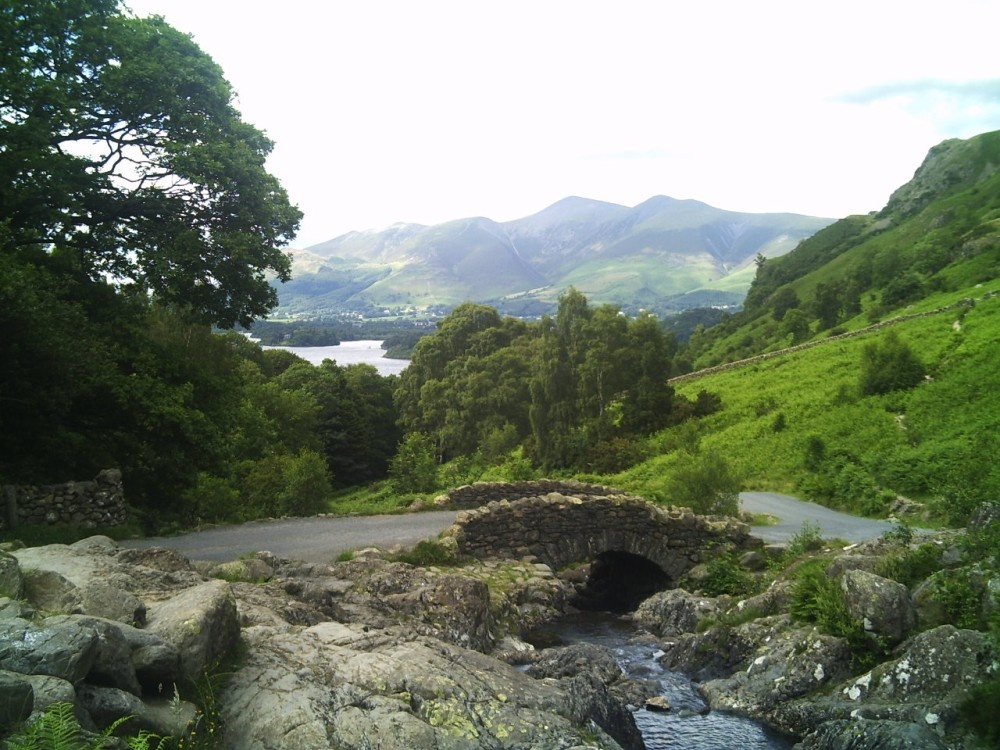
Ashness bridge, Derwent water, Cumbria. July 06 - Image by PicturesOfEngland.com member Matt Holland (view gallery)
Derwentwater is one of 16 Lakes set within the Lake District National Park in Cumbria. It is one of the most northerly of the English Lakes and is 3 miles long, 1 mile wide and 72 feet deep. 'Derwentwater' which means 'lake of the river with many oak trees' is one of the widest in the Lake District and is known as the 'Queen of the Lakes', once you experience its beautiful and majestic setting you can understand why it is named as such. The Lake and surrounding area can be explored on foot. Suggested route plans can be purchased from the nearby National Trust shop at Lakeside Car Park. Alternatively, you can take a more leisurely exploration of Derwentwater via the passenger launch service which operates round trip cruises of the Lake making stops at 'Ashness', 'Lodore', 'High Brandlehow', 'Low Brandlehow', 'Hawes End', and 'Nichol End' allowing you to hop-on and hop-off. There is also an opportunity to hire both rowing boats and motor boats for your own personalised experience which is sure to provide the whole family with lots of excitement and fun.
ID#25
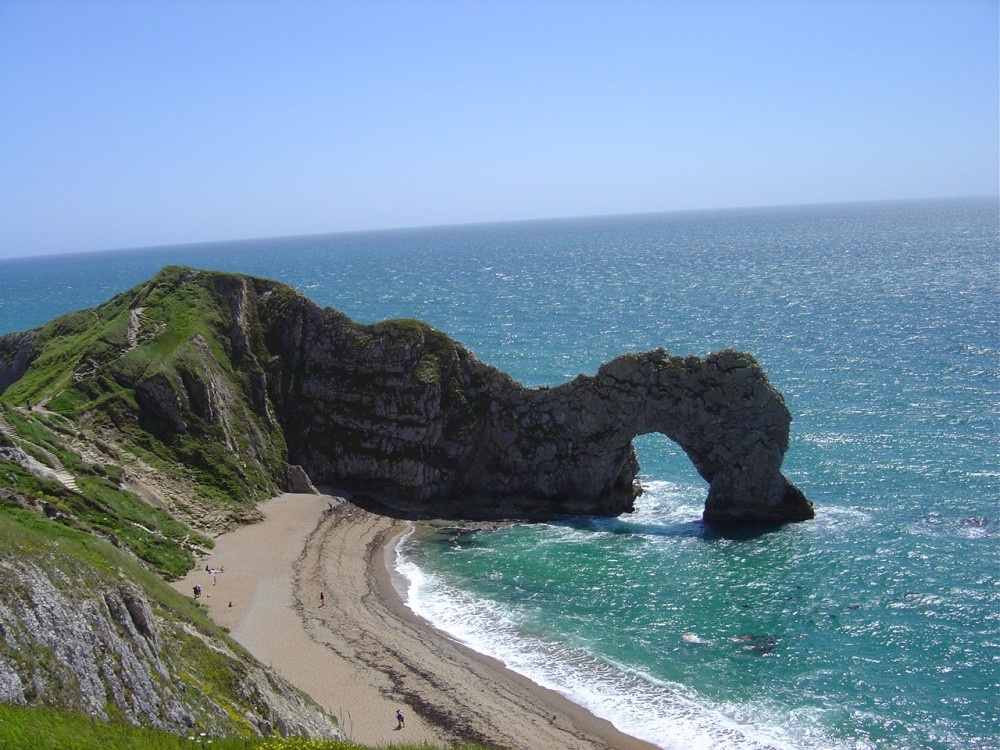
Durdle Door in Dorset - Image by PicturesOfEngland.com member lucsa (view gallery)
On a coast of fabulous high white cliffs there are few views to rival the spectacular Durdle Door. This natural phenomena, carved by the sea must rank as one of the most photographed scenes on the Jurassic Coast, it is certainly one of the coastal wonders of Britain.
It is a beautiful place, a shingle cove surrounded by rocks where a 'door' has been formed by the sea eating away at relatively soft rock, leaving an exquisite open arch of hard Portland stone. Crystal clear waters flow through the door, sweeping softly up the pretty sloping beach which is used for bathing and this, together with other little coves make it a pleasurable place for sub-aqua enthusiasts.
Lying a short distance from famed Lulworth Cove where fascinating arms of rock enfold pools of water left by a retreating tide, make this a picturesque and exciting place to explore. Lulworth has delightful thatched cottages, pleasant shops and friendly inns and quaint shops, and cafe's. At nearby Bat's Head, a smaller arch carved by waves can be seen - this is affectionately known as the 'mousehole' it is beneath massive rock formations jutting out into the sea. From the mossy headland above there are seascapes of incomparable splendour.
Places to visit include: Bowleaze Cove, Kimmeridge Bay, Swanage Railway, Corfe Castle (NT) and Wareham - pretty market town.
ID#26
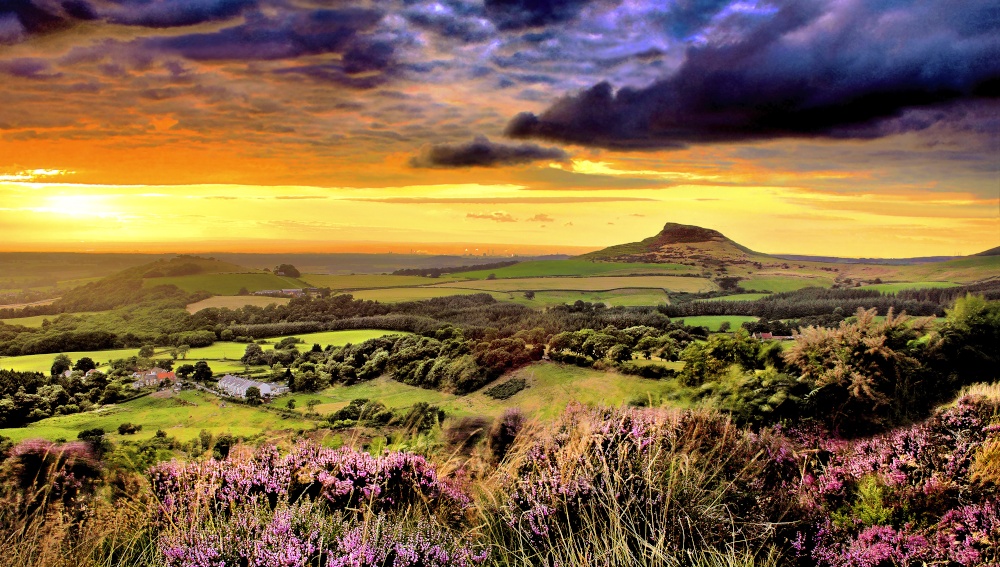
Odin's Fire - Image by PicturesOfEngland.com member Cass (view gallery)
This lofty hillside is known as the Roseberry Topping, but affectionately called the "matterhorn" by locals, it lies on the famous Cleveland Way as it crosses the North Yorkshire National Park.
In Viking days this dramatic landmark was regarded as a sacred hill, and has always been thought of as the home of the war-god Odin. A fact which appears to be neither proven nor disproved.
The scars of centuries cover the slopes of the Roseberry Topping, these are the mutilations of man as he mindlessly purloined the landscape for iron, jet, coal, alum and sandstone. Not-with-standing, there remains a stark and magnificent beauty about the Roseberry Topping as it gazes out with startling effect over the undulating countryside of the northern border of the National Park.
For the stout hearted who reach the 1,051 summit there are splendid views, these take in the North East Coastline, Captain Cook's Monument and the spectacular valley of the River Tees.
The landscape below the hill is dotted with pleasant Yorkshire villages spread amongst a patchwork of fields. Here visitors will find places of interest, typical village pubs, and friendly accommodation.
There is a wild magic about this area with many of the "out of the way" places being best explored on foot.
ID#10571
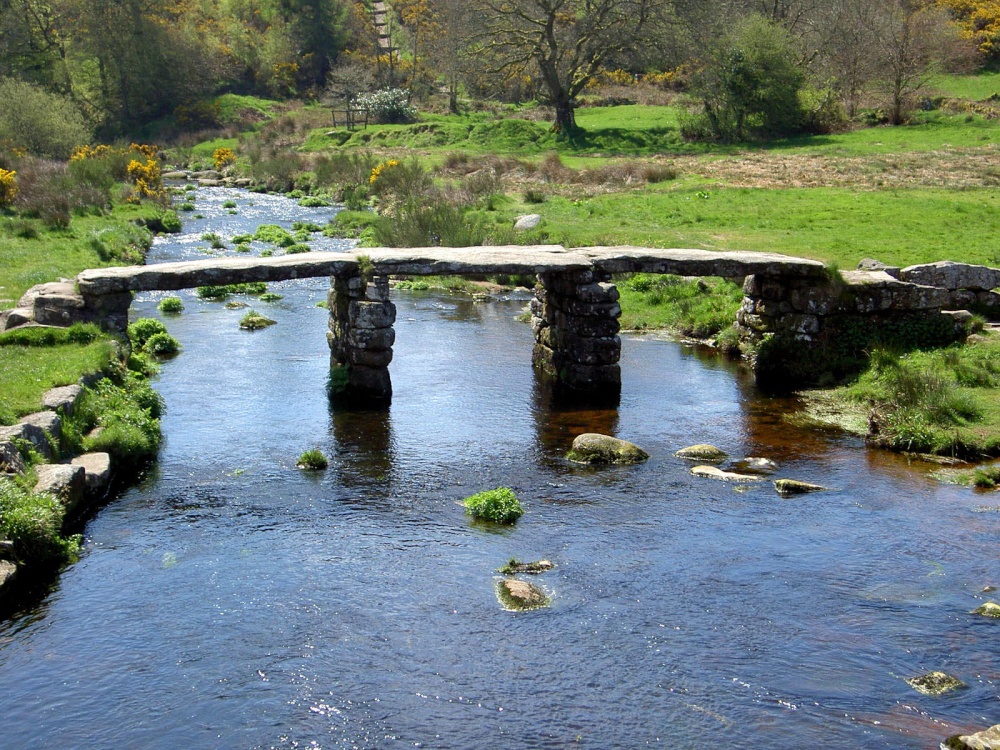
Clapper Bridge at Postbridge - Image by PicturesOfEngland.com member Paul V. A. Johnson (view gallery)
An exploration of the hauntingly beautiful Dartmoor National Park cannot be under-taken in just one short visit. To truly explore and appreciate this vast moorland region with its wealth of pleasing market towns and villages, heritage sites, waterfalls and unique hills and valley's, could well take a lifetime - so spell-binding is the scenic beauty and mystery of the moors. From the beautiful village of Belstone in the north of the moors, to bustling Ivybridge in the south, is a magical mystery tour of overwhelming splendour and interest, unsurpassed by any other place in the land.
Of interest to all who come here are the hardy Dartmoor ponies, who together with sheep and cattle, wander the moors at will. These lovely creatures are considered 'wild' but interestingly, all the ponies have owners and are rounded up each autumn.
Widdecome-in-the-Moor is a much loved village whose fame spread through the song telling the tale of 'Old Uncle Tom Cobbley' and his friends. The village still holds its annual fair, a lively event attended from miles around, and Uncle Tom is commemorated by the village sign. I am constantly reminded of this happy place by a piece of porcelain bought there many years ago, showing Uncle Tom surrounded by Tom Pearse, Harry Hawk, Jan Stewer, Bill Brewer, Daniel Whiddon, Peter Davey and Peter Gurney!
The pleasant town of Ashburton prospered as a Tin-mining town and later, in medieval times wool became the focus on which the town's fortunes depended. Some of the town's most important buildings were built with 'wool' money. Its church is extremely handsome, it dates from the 15th-century and has a splendid tower and a medieval roof. The market town of Buckfastleigh was also an important centre for the wool trade on which its fortunes were founded. These days this attractive town benefits from tourists who flock to Dartmoor, it offers a pleasant starting point for touring. Amongst its many attractions is magnificent Buckfast Abbey. The Abbey was built in the 10th-century by Benedictine monks, the interior has stunning mosaic flooring. Buckfastleigh also has a Butterfly farm and an Otter Sanctuary. The town has regular markets and several festivals are held throughout the year.
Manaton village lies in a high moorland position and is best known for rock and boulder climbing. The River Bovey flows close to this lovely old stone village which shows delightful cottages scattered around a pleasing village green. There are spectacular views all around. Just beneath Manaton, giant size boulders form the back-drop for the gushing waters of the Becka Falls, an impressive sight viewed in rising mist, following rain.
Another delightful place is Moretonhampstead set in the idyllic Teign Valley. To follow the Teign's course across the moors is to experience some of Dartmoor's loveliest countryside as the river moves through quiet, sheltered valley's and boulder strewn gorges. A short distance from Moretonhampstead, the Teign flows under a 16th-century bridge. Fingles Bridge, is thought to have been part of a pack-horse track in medieval times. All along here the river banks are quite beautiful and show wonderful species of river-wildlife. Other riverside beauty spots include Dartmeet and Huccaby.
The pleasant village of Chagford, like Manaton, makes an ideal centre from which to explore the moors on foot, or join in a pony trekking trip. Some of the most spectacular viewpoints for walkers include Buckland Beacon, Chinkwell Tor and Kestor Rock to name but a few.
Dartmoor is a splendid, wild and untamed land within a land. It is a region of dark granite rocks and towering tors. Some of these tors, such as Belliver and Vixen Tor have fired mans imagination for decades. In the famous Sherlock Holmes adventure 'Hound of the Baskervilles' they certainly struck a chill in Dr. Watson's heart! In certain moods, Dartmoor can be awesome and daunting as granite tors rise steeply over marshy bogs and rolling moorland, and dark clouds descend filling the air with an unforgiving menance. This is only one face of the fascinating diverse scenery of Dartmoor, mostly it is bright and shining, a land of myths and legends abounding through hilltop and lowland villages. A land criss-crossed by farmsteads and agricultural holdings, great houses, ancient churches and relics from old industries which for centuries moorland folk, garnered a living. A land of towering forests teeming with wildlife, dancing rivers and merry little streams, but most of all, it is a spirited, gloriously uninhibited and joyous land, that fortunately has remained just as nature intended - sublime, and supremely beautiful.
Places to visit include; Castle Drogo, The Dart Valley Railway, Yelverton Museum, Burrator Reservoir, Harford Moor, Princetown, Ventford Reservoir, Hound Tor Medieval Village, The Miniture Pony Centre and Warren House Inn, an ancient public house in one of the most solitary spots on Dartmoor.
Things to do; Walking, Climbing, Riding, Pony Trekking, Cycling and Fishing. Dartmoor has interesting antique shops and galleries, displaying the work of local artists. Village and small town shops cater for every day needs, whilst the larger towns provide bigger and better shopping facilities. The many inns and public houses on the moor are warm and welcoming, they provide hearty food and good ale!
ID#10062
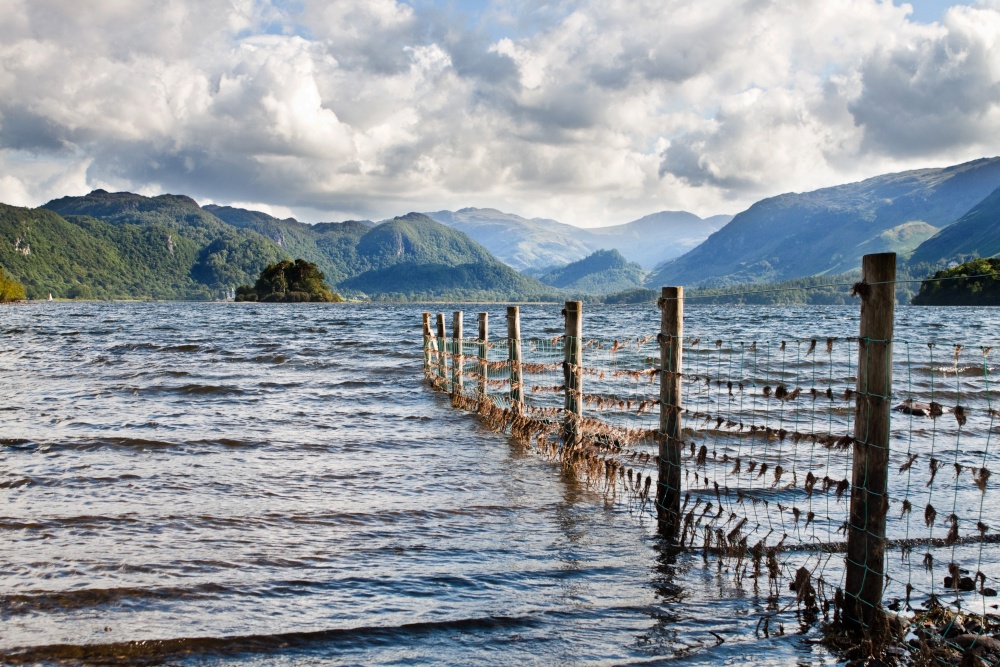
Derwentwater - Image by PicturesOfEngland.com member Dave John (view gallery)
Derwentwater is one of 16 Lakes set within the Lake District National Park in Cumbria. It is one of the most northerly of the English Lakes and is 3 miles long, 1 mile wide and 72 feet deep. 'Derwentwater' which means 'lake of the river with many oak trees' is one of the widest in the Lake District and is known as the 'Queen of the Lakes', once you experience its beautiful and majestic setting you can understand why it is named as such. The Lake and surrounding area can be explored on foot. Suggested route plans can be purchased from the nearby National Trust shop at Lakeside Car Park. Alternatively, you can take a more leisurely exploration of Derwentwater via the passenger launch service which operates round trip cruises of the Lake making stops at 'Ashness', 'Lodore', 'High Brandlehow', 'Low Brandlehow', 'Hawes End', and 'Nichol End' allowing you to hop-on and hop-off. There is also an opportunity to hire both rowing boats and motor boats for your own personalised experience which is sure to provide the whole family with lots of excitement and fun.
ID#25
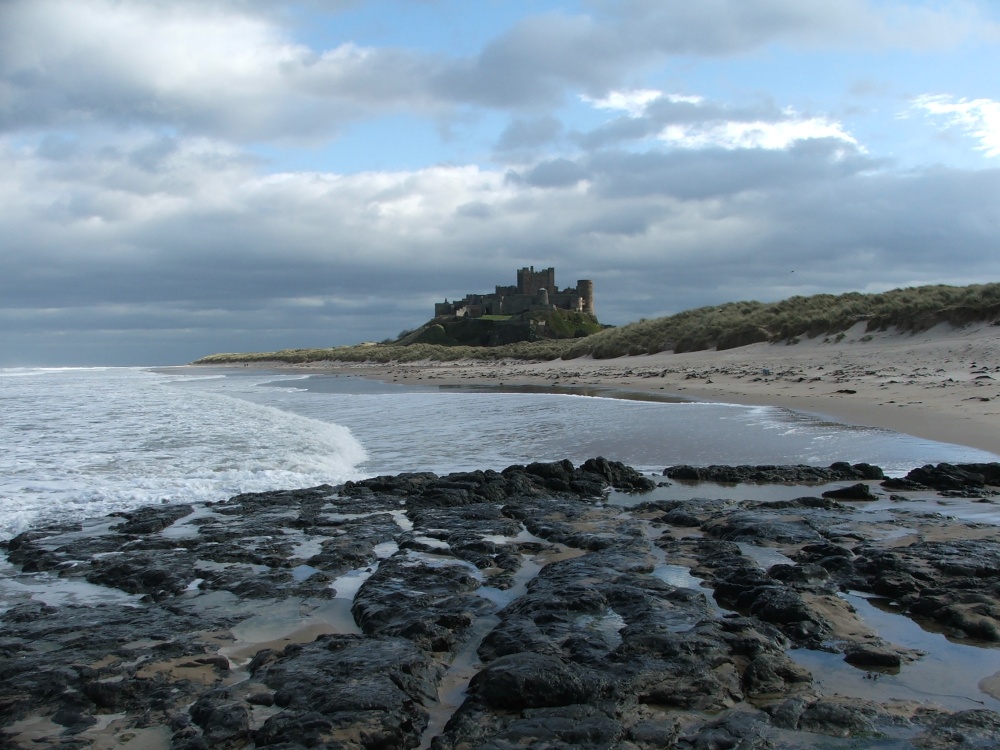
Rock solid - Image by PicturesOfEngland.com member Graham John Willetts (view gallery)
Bamburgh's huge Norman castle was once the seat of the Kings of Northumbria. It is set on a Basalt outcrop overlooking the limitless beauty of the North Sea coastline with far reaching views of the Farne Islands and Holy Island.
The castle has a turbulent history, during the War of the Roses it was a Lancastrian stronghold, and it was to Bamburgh that Henry VI and his wife Queen Margaret of Anjou fled, following the Battle of Hexham when they were defeated by the Yorkists.
Bamburgh Castle is in private ownership, it is the home of the Armstrong family. The glittering castle we see today is due to the tireless work of the Ist Lord Armstrong, wealthy industrialist, who began the restoration of Bamburgh in 1890. The late Lord Armstrong continued with his ancestors inspirational work and saw his dream through to fruition. It is now one of the most beautiful and best preserved castles in England. The rich interior and magnificent collections on display are matched only by the castle's idyllic location.
All the rooms on view contain fine furniture, tapestries, paintings, exquisite porcelain and in the Armoury, you can see Arms and Armour dating from the 15th to the 19th century including pikes and muskets issued to the militia at the time of the Napoleonic Wars. Rooms open to public view include a series of reception rooms, the magnificent King's Hall, the Cross Hall, the Bakehouse, the Victorian Scullery and Dungeons. The Ist Lord Armstrong was an engineer, inventor and industrialist. His memory is honoured by a museum dedicated to his life and times which is sited in what was once the Laundry.
Bamburgh Castle is open from April to October, it is a place of historic charm and exceptional beauty which is well worth a visit.
ID#102
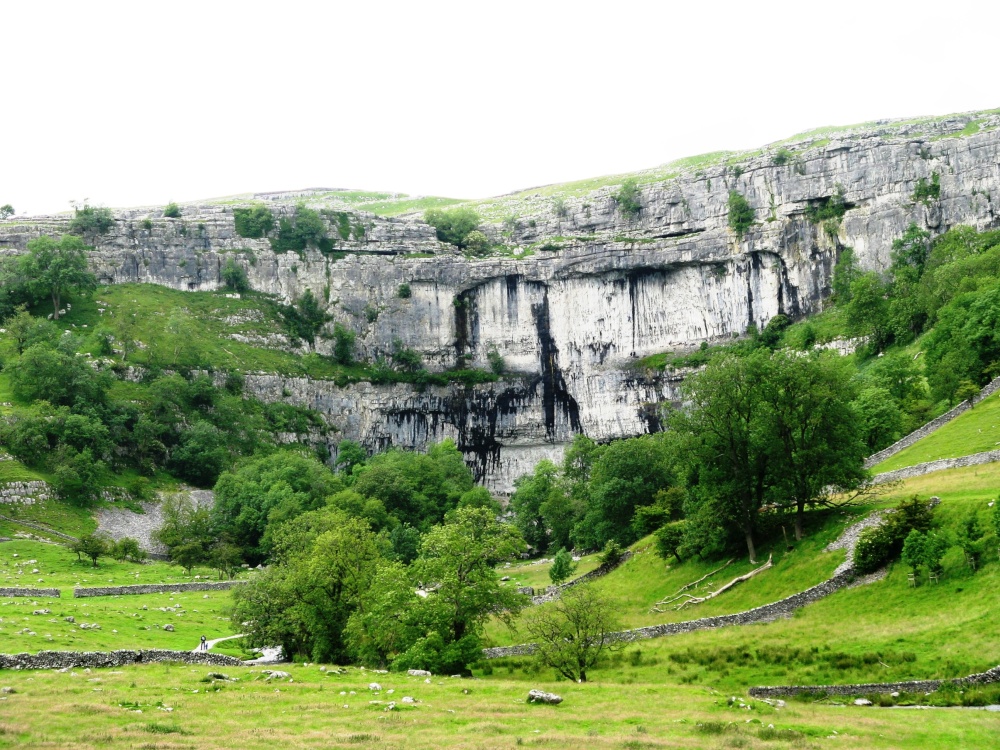
Malham Cove - Image by PicturesOfEngland.com member JauntyJane (view gallery)
A natural limestone formation which is a national beauty spot, near Malham, North Yorkshire
ID#10760
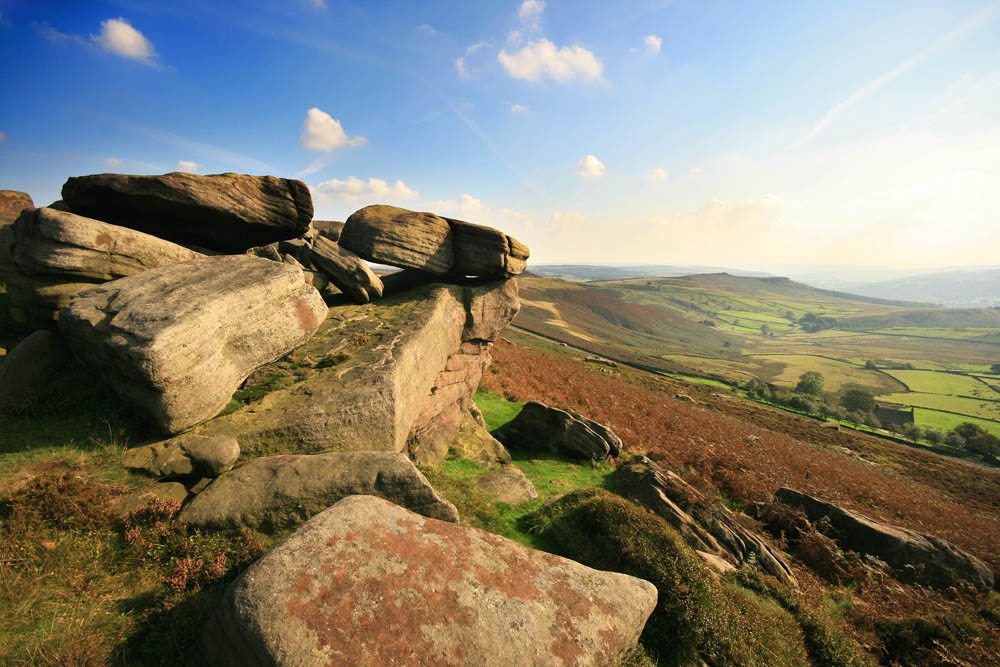
Stanage Edge - Image by PicturesOfEngland.com member John Godley (view gallery)
Stanage Edge is an elevated gritstone edge or enscarpment that stretches for around 4 miles giving extensive views across the Peak District's Hope Valley, the Dark Peak moorlands, and beyond. Indeed, it is said that on a clear day you can even see the Malvern Hills, which are 60 miles away or more, but it is the nearer views of the peaks and windswept moors that people come to see, and that have been such an inspirtation for many, including the famous Charlotte Bronte who's novel Jane Eyre features many places that match locations around the area, such as North Lees Hall ("Thornfield Hall") on the outskirts of the nearby historic village of Hathersage.
The highest point of Stanage Edge is the High Neb, which is 1,503ft above sea level, and the edge is extremely popular with walkers, runners and particularly climbers who come to experience one of Britain's most popular climbing spots and take in the incredible views.
There was once a paved packhorse trail along the top of the edge, with parts still remaining today, and descending the edge is what is known as the 'Long Causeway' - a medieval packhorse route that ran between Sheffield in South Yorkshire, and Hathersage in Derbyshire. The route was used by traders to bring salt to Yorkshire from the Cheshire Salt Mines during the Middle Ages, and later during the 18th century, carts would carry other goods including barrels of tar, treacle, oil, lead and grinding stones.
The Edge itself was once quarried for large grinding stones known as millstones, and the remnants of this era can still be seen today with large discarded millstones strewn around the edge in places such as at High Neb where they have become an indelible part of the landscape and are often used as a symbol of the Peak District itself.
More recently, Stanage Edge was featured in the 2005 remake of the classic 'Pride & Prejudice' starring Keira Knightly, and many people seek out the exact spot where she stood in the film, which is now known as 'Keira Knightly Rock'.
ID#5483
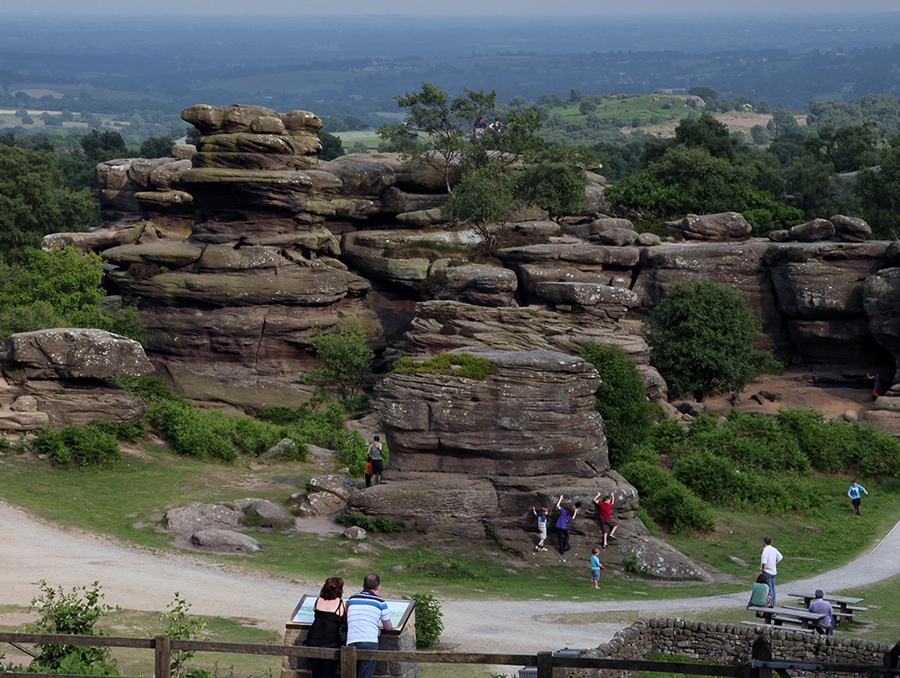
Brimham Rocks, near Harrogate - Image by PicturesOfEngland.com member Allan Rostron (view gallery)
At a height of nearly 300m, Brimham Rocks give spectacular views over the surrounding countryside of the Nidderdale. . The curious rock formations are scattered over approx 50 acres on Brimham Moor and provide a great variety of shapes. Look out for 'The Dancing Bear', and other formations such as 'the druids writing table' 'E.T' and a giant mushroom! The rocks are spectacular stacks of millstone grit carved out over thousands of years by the wind and rain. Its a great place to go for climbing and leisure walks.
ID#19
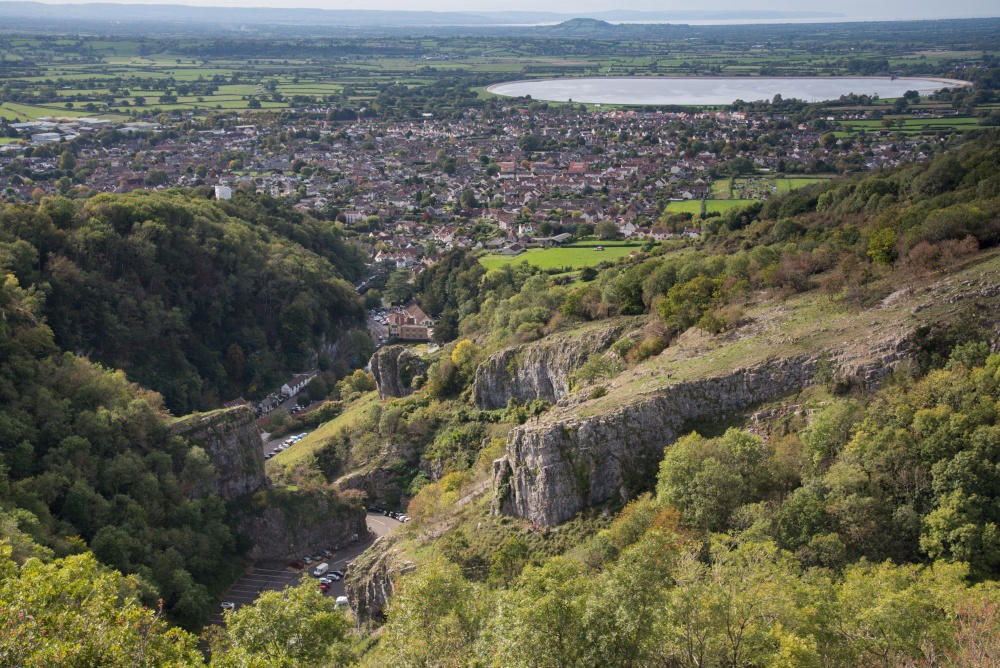
Cheddar Gorge - Image by PicturesOfEngland.com member Zbigniew Siwik (view gallery)
The mile or so of pale-grey limestone cliffs rising above the winding road through Cheddar is awesome in its untamed beauty, it appears wild and exciting, far removed from the village which these days exists on pure commercialism. The road leads through to the beautiful Mendip Hills, these have many remote areas and present a sparsely populated landscape dotted with just a few farms, and the occasional inn used by "cavers" locals and tourists. The views all around are quite dramatic, especially when the mist creeps over, mist rises quickly in these parts and it is not unknown for walkers, or climbers to loose their bearings.
The most spectacular views of the Somerset countryside are to be enjoyed on a clear summers day from the top of the cliffs, easily reached by "Jacob's Ladder" at the northern end of Cheddar. Cheddar boasts England's highest inland cliffs, these provide a nesting place for Peregrine Falcons.
These days the town is dominated by its famous show caves, Cox's and Gough's, both contain fine stalagmites and stalactites. Gough's cave is the largest of the caves, it was discovered in 1890 by sea captain Richard Gough, for whom it is named. This leads to the Diamond Chamber and Solomon's Temple. A thrilling exhibition explains the history of the caves, how they were carved out over million years of ice-age meltwater, and how early man managed to survive the ice-age period. Bones of possibly cannibalistic prehistoric men have been found at Cheddar, thus Gough's Cave is the country's first cannibal site.
Cox's Cave is startling in its beauty, it is tiny with little narrow passages, full of amazing colours and picturesque reflective pools. This was discovered by a man working for local mill-owner George Cox, whilst collecting rocks to use as building material in 1837.
A tour of the caves reveals a world of beautiful colour, magical crystals, adventures with wizards, goblins, a fairy princess, and even a smoke-breathing dragon! It may be a little precarious in some parts, but for sheer atmosphere and splendour it is well worth taking the tour.
In the village there is a collection of all the usual tourist trap shops, pubs, restaurants and fish and chips. There is a good market cross and a lovely 14th century church with a fine tower, tie-beam roof, and carved stone pulpit from the 15th century.
In the summer months an open-top bus operates a tour of the best sights of the town, these can be enjoyed at anytime between March and September.
During the latter half of the 20th century, excavations carried out close to Manor Farm failed to reveal any trace of Cheddar's one-time Anglo-Saxon palace.
ID#23
| Article Title | Author | Date |
| Stonehenge | David Coe | 23rd January 2024 |
| Derwent Dam: A Historic Icon in the Heart of Derbyshire | David Coe | 14th January 2024 |
| The Native Trees of England: A Botanical Tapestry | David Coe | 15th December 2023 |
| Stoke-on-Trent: The Potteries Hub | David Coe | 12th December 2023 |
| England's 'Heritage at Risk Register' 2023 | David Coe | 11th December 2023 |
| 10 of the prettiest villages in the Lake District, Cumbria | poe | 16th March 2023 |
| Where to see Daffodil Displays in the South West of England | poe | 3rd March 2023 |
| 10 Famous Landmarks in Dorset | poe | 1st March 2023 |
| List of popular Dorset market towns including market day | poe | 1st March 2023 |
| 10 Best Historic Attractions to visit in York, England | poe | 16th May 2022 |